
<h2>Example 1: Embedded data</h2>
<svg id="example1" xmlns="http://www.w3.org/2000/svg" xmlns:xlink="http://www.w3.org/1999/xlink">
<image x="0" y="0" width="5" height="5" xlink:href="data:image/png;base64,iVBORw0KGgoAAAANSUhEUgAAAAUAAAAFCAYAAACNbyblAAAAHElEQVQI12P4//8/w38GIAXDIBKE0DHxgljNBAAO9TXL0Y4OHwAAAABJRU5ErkJggg=="/>
</svg>
<h2>Example 2: Remote image</h2>
<svg id="example2" version="1.1" xmlns="http://www.w3.org/2000/svg" xmlns:xlink="http://www.w3.org/1999/xlink">
<image x="0" y="0" width="275" height="95" xlink:href="http://www.google.co.uk/images/srpr/logo3w.png" />
</svg>
<h2>Example 3: Local image</h2>
<svg id="example3" xmlns="http://www.w3.org/2000/svg" xmlns:xlink="http://www.w3.org/1999/xlink">
<image x="0" y="0" width="136" height="23" xlink:href="/img/logo.png" />
</svg><svg width="700" height="660">
<defs>
<pattern id="image" x="0" y="0" patternUnits="userSpaceOnUse" height="1" width="1">
<image x="0" y="0" xlink:href="url.png"></image>
</pattern>
</defs>
<circle id='top' cx="180" cy="120" r="80" fill="url(#image)"/>
</svg>